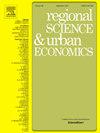城市拉动:便利设施和就业的作用
IF 2.9
2区 经济学
Q1 ECONOMICS
引用次数: 0
摘要
本文利用社区消费便利设施的新测量方法来证明,美国城市的房价和租金可能几乎是由便利设施和就业机会决定的。我们扩展了阿隆索-穆特-米尔斯模式,允许居民从城市内的旅行中获得便利。该模型提供了标准的可估计的对数线性定价方程,以及基于目的地在休闲时间的受欢迎程度和在全市范围内获得消费便利设施的新措施。我们发现,我们的便利措施增加了大量的解释力,在量级上产生了巨大的影响,并将通勤成本的天真估计减少了30%。与就业机会相关的租金弹性比与便利设施相关的租金弹性大20%-50%。使用各种替代措施得出的结论是成立的,既不受密度的影响,也不完全由商业机构的位置来解释。这些结果表明,城市对就业地点的变化具有潜在的弹性。本文章由计算机程序翻译,如有差异,请以英文原文为准。
Urban pull: The roles of amenities and employment
This paper leverages new measurement of neighborhood consumption amenities to demonstrate that housing prices and rents in U.S. cities are likely determined nearly as much by access to amenities as by access to employment. We extend the Alonso–Muth–Mills model, allowing residents to derive utility from within-city trips to amenities. The model delivers standard estimable log-linear pricing equations as well as new measures of local amenities—based on a destination’s popularity during leisure hours—and of access to consumption amenities city wide. We find our amenity measures add substantial explanatory power, have large effects in magnitude, and reduce naive estimates of commute costs by 30%. Elasticities of rents with respect to employment access are 20%–50% larger than those with respect to amenity access. The findings hold using a variety of alternative measures and are neither driven by density nor fully explained by the locations of business establishments. These results suggest the potential resilience of cities to changes in employment locations.
求助全文
通过发布文献求助,成功后即可免费获取论文全文。
去求助
来源期刊

Regional Science and Urban Economics
Multiple-
CiteScore
5.30
自引率
9.70%
发文量
63
期刊介绍:
Regional Science and Urban Economics facilitates and encourages high-quality scholarship on important issues in regional and urban economics. It publishes significant contributions that are theoretical or empirical, positive or normative. It solicits original papers with a spatial dimension that can be of interest to economists. Empirical papers studying causal mechanisms are expected to propose a convincing identification strategy.
 求助内容:
求助内容: 应助结果提醒方式:
应助结果提醒方式:


